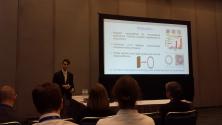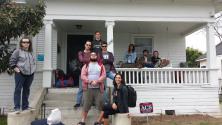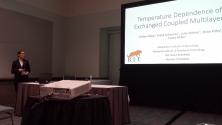American Physical Society March Meeting
March 5, 2018
Los Angeles, California
Meeting host: By:Christopher Car
SPS Chapter:
Deep in the heart of Los Angeles, California lies an immense convention center whose size is dwarfed only by the expertise of the physicists who filled it during this year’s APS March Meeting.
With the topics of quantum information, materials science, biophysics, and nearly everything in between being presented at the conference, there was something for everyone. But before my group from the University of South Florida could dive headfirst into the wealth of knowledge on display, it was necessary to first complete a bit of legwork.
My undergraduate colleagues and I learned that upon arrival at the convention center, standard protocol is to confirm pre-registration by picking up conference badges and program guides. While in theory this seems like a straightforward task, the presence of nearly a thousand attendees added a layer of complexity. Lesson learned? Always arrive a day early in order to bypass the controlled chaos of the crowds and get familiarized with the scenery.
First on my group’s agenda was to attend an undergraduate research session featuring over a dozen talks by undergraduate presenters, two of whom were classmates of ours. I shared their butterflies as they took the stage, but this feeling soon subsided once their presentations began and the physics consumed them. It was an invaluable experience to observe my peers in such an environment. While I didn’t have research of my own to present at this meeting, soon the time will come when the tables turn and it’s me in the spotlight, them in the audience. Hopefully I can learn from their success and deliver an equally impressive talk, worthy of the same honors they received!

Hosted on the second, third, and fourth days of the conference were the undergraduate poster sessions, events where the wine flowed as freely as the physics. Hundreds of students participated in these sessions; they could have constituted a conference all by themselves! As I wandered down the rows, several posters sparked my interest but one in particular captured my attention. Xiangyu Cao from UC Berkley stood proudly in front his research entitled, “Chaos in Classical Simulations of Quantum Dynamics.” After a lengthy conversation where I struggled to apply my limited knowledge of quantum mechanics and differential geometry, Xiangyu was finally able to get the gist of his work across to me.
The trouble with applying chaos to quantum systems is that they don’t behave very nicely when you let them evolve with time and then try to turn back the clock. The trick to getting around this problem, as Xiangyu and his fellow researchers discovered, is to truncate the manifold in Hilbert Space on which the quantum system lives. From here, a technique known as “time-dependent vibrational principle” can be applied in order to track the evolution of the system’s energy and model it appropriately. If these methods seem at all abstract, fear not because you’re not alone. Only some of these concepts are covered in undergraduate quantum mechanics and to actually carry out this work, one must be equally strong in pure mathematics as they are physics. However, despite this and the fact that the nuances of Xiangyu’s work escaped me, I still felt honored to speak to a fellow undergraduate who was pushing the field of quantum mechanics beyond what one might find in university level textbooks.
Outside of the undergraduate poster sessions, I had the pleasure to attend numerous lectures by researchers who are leading the frontiers of physics in their respective fields. One such researcher whose presentation I witnessed and then had the opportunity to speak with afterward is Dr. Kristen Stojak Repa, a Post-Doctoral Researcher from Rochester Institute of Technology. Her talk, “Temperature Dependence of Exchanged Coupled Multilayers,” was far outside the realm of anything I had been exposed to before, a reason it was all the more fascinating.
Dr. Repa’s research, in collaboration with the National Institute of Standards Technology, focused on using the techniques of reflectometry and magnetometry to investigate what happens when samples of certain magnetic materials are stacked in particular configurations and then cooled to various temperatures. In regards to the magnetometry technique, Dr. Repa explained to me, “What we measure is the voltage change in the coil [of the Vibrating Sample Magnetometer] as our sample passes through. This voltage is then converted to a magnetic moment, which can then be converted to a magnetization.” When asked if there were any roadblocks that Dr. Repa faced in her research, she informed me that she’s been very fortunate to get good results, but “the hardest thing about this sample is to figure out exactly what’s going on. We have strong evidence for what we think is happening, but it’s difficult to pinpoint the WHY. That’s why we’re still conducting measurements on this sample and making others like it.”
It was extremely humbling to hear this information. As an undergraduate student, my perception of research at the highest level was that those conducting it are sure of themselves throughout the entire process. While this may be true to a small degree, it turns out that top researches are constantly questioning their ideas and results, taking great care not to fool themselves with predispositions or desires for a particular theory to be correct. Having only a few months of research under my own belt, Dr. Repa’s words hit home and now serve as guidance for how I should examine my own work moving forward.
I consider myself very fortunate to have had the opportunity to speak so extensively with Dr. Repa. Before our conversation drew to a close that day, she left me with a few more pieces of advice which helped put things into perspective. One of these I would like to share with other undergraduates similarly enthusiastic in their pursuit of graduate school, and ultimately a life of academia, in the near future:
“You will miss out on a lot of ‘life things’ by joining grad school. It wasn’t so hard at first, but it got harder as time went on. I watched a lot of my friends get permanent jobs, get married, have kids, buy houses… and I was still renting an apartment, eating ramen, and working for $20,000/year. Eventually, you get used to living frugally, but it’s still difficult to see others ‘pass’ you. It’s important to constantly remind yourself that you’re doing this for a reason and that it’s only temporary.”
The week I spent in Los Angeles with friends and colleagues from my university is a week I’ll never forget. Not only did I learn all about the variety of research being performed worldwide and the inclusive culture associated with it, I also learned something about myself. Physics is equally as beautiful as it is complicated, just like the sacrifice it demands. I’m not sure what the field will be like years from now, but my attendance at the APS March Meeting has solidified that whatever it may be, I want to be a part of it.



